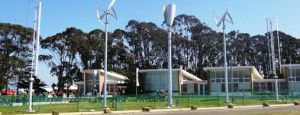SF Mayor Lee fights supervisors over green power
by Wayne Lusvardi | April 25, 2014 10:13 am
 It’s green power vs. greenbacks.
It’s green power vs. greenbacks.
A political power battle is brewing in San Francisco over which entity of government is going to carry out the local implementation of the mandate by the state of California for 33 percent renewable[1] energy by the year 2020. The battle stems from San Francisco being California’s only consolidated city-county. According to SF311[2], that means, “The mayor is also the county executive and the county board of supervisors acts as the city council.”
The battle pits Mayor Ed Lee on one side and county Supervisors John Avalos and David Campos[3] and progressive activists on the other side. The battle is over whether San Francisco needs CleanPowerSF[4] to accomplish its clean energy goals. CleanPowerSF is a new municipal electric utility authorized under the state’s Community Choice Aggregation[5] law. The CCA law allows cities to unplug from monopoly utilities such as PG&E and form a cooperative to buy power or build their own power plants.
The civil war over clean power in San Francisco flashed to the public’s attention on March 31 when Lee dramatically whited-out[6] the renewable energy goals to be carried out by CleanPowerSF from the city’s Climate Action Plan. Instead of merely deleting the text, the mayor apparently wanted everyone to know that CleanPowerSF was not going to carry out the compliance of the state’s 33 percent clean energy goals for the city.
San Francisco voters repeatedly have rejected[7] ballot measures to take over the city’s private regulated electric monopoly, PG&E. As recently as 2008, voters pulled the plug on local Proposition H[8], which would have required the city to get 51 percent of its energy from renewable sources by 2017.
Under the CCA law, all electricity customers would be automatically transferred to SFCleanPower unless they specifically choose to opt out. PG&E would continue to handle the billings, maintenance, transmission and distribution of electricity for the entire city and county of San Francisco. In other words, CleanPowerSF would be the power provider and PG&E merely the power conveyor, distributor and biller.
SFCleanPower advertises that it can buy electricity and build power plants cheaper than PG&E. San Francisco has a population of 825,000, while PG&E has 5.1 million customers statewide.
In 2010, then-Mayor Gavin Newsom, now California’s lieutenant governor, set a goal for the city to be powered by 100 percent by renewable energy[9] in 10 years. Even current Mayor Lee has issued directions to achieve this goal. This would essentially mean solar and wind power.
Fog Power
This is in a city that has 106 cloudy days[10] per year on average and where fog is a regular feature of San Francisco summers. A well-known quote mistakenly attributed to Mark Twain[11] is, “The coldest summer I ever spent was a summer in San Francisco.”
And as Carl Nolte wrote in the title to an article in the San Francisco Chronicle on Aug. 2005, “Fog Heaven: The Fog Will Come Out Tomorrow or Maybe Not – It’s Summer in the City and That Means Gray Skies.”[12]
 Wind speeds in the bay reach 20 to 30 miles per hour[13], enough to power wind turbines. But ugly, giant wind machines would have to be placed around the Golden Gate and on the Coastal Range hills to generate wind energy. This would be a virtual impossibility with opposition rising from the California Coastal Commission, environmentalists and the tourist industry.
Wind speeds in the bay reach 20 to 30 miles per hour[13], enough to power wind turbines. But ugly, giant wind machines would have to be placed around the Golden Gate and on the Coastal Range hills to generate wind energy. This would be a virtual impossibility with opposition rising from the California Coastal Commission, environmentalists and the tourist industry.
Currently, the only wind machines in the mouth of the bay are located on federal land at the Golden Gate National Park (shown in the image nearby).
After spending $4.1 million[14] on planning over the last 10 years to launch an alternative electric buying cooperative to PG&E, the program still remains in the fog and up in the air.
CCA[15] electric cooperatives are already in place in Marin County and in the San Joaquin Valley. Sonoma County, Berkeley, and San Diego are in various stages of approving such cooperatives.
A recent opinion poll conducted in the liberal university town of Davis by the electrical worker’s union concluded that a plurality was pleased with continuing service from PG&E rather than forming an electricity co-op (no longer posted online – see here[16]).
And the City of Hercules, population 24,060[17], is moving toward a private solution. The city council approved an agreement on May 28, 2013, for PG&E to take over the Hercules Municipal Utility[18], rather than form an electricity co-op or join another co-op. Hercules[19] is located north of the San Francisco Bay.
So the examples of what to do are before San Francisco. But for now the electricity policy fog remains.
- 33 percent renewable: http://www.sfgate.com/business/article/Brown-signs-law-requiring-33-renewable-energy-2375758.php
- According to SF311: http://sf311.org/index.aspx?page=262
- Mayor Ed Lee on one side and county Supervisors John Avalos and David Campos: http://www.sfbg.com/politics/2014/03/11/miraculous-and-mysterious-disappearing-reappearing-clean-power-sf-data
- CleanPowerSF: http://www.sfwater.org/index.aspx?page=576
- Community Choice Aggregation: http://en.wikipedia.org/wiki/Community_Choice_Aggregation
- whited-out: http://www.sfbg.com/politics/2014/03/11/miraculous-and-mysterious-disappearing-reappearing-clean-power-sf-data
- rejected: http://www.nbcnews.com/id/27360701/ns/us_news-environment/t/san-francisco-vote-who-delivers-electricity/#.U1jEk8evzBJ
- Proposition H: http://www.sfgate.com/politics/article/In-S-F-voters-defeat-Prop-H-for-city-utility-3186957.php
- 100 percent by renewable energy: http://www.sfenvironment.org/sites/default/files/fliers/files/sfe_re_renewableenergytaskforcerecommendationsreport.pdf
- 106 cloudy days: http://www.bestplaces.net/climate/city/california/san_francisco
- Mark Twain: http://www.snopes.com/quotes/twain.asp
- Fog Heaven: The Fog Will Come Out Tomorrow or Maybe Not – It’s Summer in the City and That Means Gray Skies.”: http://www.sfgate.com/bayarea/article/FOG-HEAVEN-The-sun-will-come-out-tomorrow-Or-2615710.php
- 20 to 30 miles per hour: http://ggweather.com/sf/narrative.html
- $4.1 million: http://en.wikipedia.org/wiki/CleanPowerSF
- CCA: http://www.cpuc.ca.gov/PUC/energy/Retail+Electric+Markets+and+Finance/070430_ccaggregation.htm
- here: http://calwatchdog.com/2014/03/20/poll-davis-voters-oppose-socializing-electricity/
- 24,060: http://en.wikipedia.org/wiki/Hercules,_California
- Hercules Municipal Utility: http://www.pgecurrents.com/2013/05/29/contra-costa-county-hercules-approves-pge-purchase-of-hercules-municipal-utility-assets/
- Hercules: http://relocationbreakthroughs.com/ContraCostaMap.gif
Source URL: https://calwatchdog.com/2014/04/25/sf-mayor-lee-fights-supervisors-over-green-power/